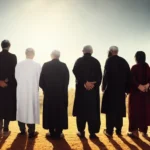Exploring the empirical evidence for various religions and their claims.
In this comprehensive article, we delve into the question of what evidence supports the truth of any religion. We will explore a variety of religious traditions, examining the historical, archaeological, and scientific evidence that has been presented in support of their claims.
The Historical Evidence for Religion
What evidence supports the truth of any religion? It’s like asking whether we can truly know if our favorite book tells the whole story. History, after all, is a vast library of tales, each one claiming to be true and profound.
Is there anything concrete in history that backs these claims? Let’s take a closer look at how religions like Christianity, Islam, and Buddhism have developed over time through historical evidence.
For instance, the early Christian Church found its roots in Jerusalem during the first century CE. Could we find any physical or written records from that period to verify these origins? The Acts of the Apostles, for example, provides a narrative of the church’s growth, but do historical documents and artifacts confirm it?
The Gnostic Gospels, discovered in the 1940s, shed light on alternative Christian traditions from early times. These texts show that Christianity was more diverse than previously thought, challenging our understanding of its origins.
Then there’s Islam. The life and teachings of Muhammad are central to the religion, but what does history tell us? The Sira, or biography of Muhammad, written by Ibn Ishaq in the 8th century CE, offers a detailed account. However, historians debate its accuracy and how much is based on oral traditions.
Buddhism, too, has rich historical evidence. The Life of the Buddha recounts his enlightenment and teachings. Archaeological findings such as stupas (Buddhist shrines) dating back to the 3rd century BCE provide physical proof of the religion’s presence in India.
The question remains: How do we reconcile these historical accounts with religious texts? Are they just myths, or are there truths hidden within them?
Archaeological Evidence for Religion
Imagine stepping into a time machine, traveling back to ancient civilizations where religion was not just belief but a way of life. Archaeological evidence from these distant lands offers us a glimpse into the hearts and minds of our ancestors. How do we decipher the stories carved in stone or buried under layers of soil? Are they the keys to understanding religious truths?
Consider the Canaanite temples discovered in modern-day Israel, dating back thousands of years. These structures not only reveal architectural styles but also provide insights into the worship practices and beliefs of ancient peoples. Do these ruins tell us about a divine presence or are they merely remnants of human imagination?
The steles found in Egypt offer another layer of evidence. These stone tablets bear inscriptions detailing religious rituals, deities, and even prophecies. Could the gods truly have spoken through ancient rulers? Or are these just cleverly crafted tales to maintain power and control over the populace?
In Mesopotamia, the ruins of Ur provide evidence for one of history’s earliest known polytheistic religions. Temples, ziggurats, and artifacts all point towards a complex religious system that influenced later cultures. Do these findings suggest an organized religion with structured beliefs or are they simply symbols of the era’s cultural diversity?
Archaeologists have also uncovered inscriptions detailing the worship of Dionysus in ancient Greece, depicting rituals and practices surrounding this deity. Could these vivid accounts give us a deeper understanding of the nature of divine beings and their roles? Or are they just tales told around campfires to explain natural phenomena?
The list goes on with findings from Roman temples, Norse runes, and even Mayan pyramids, each telling a piece of the religious puzzle. Are these artifacts and inscriptions the tangible evidence of divine truths or merely human attempts to make sense of the world around them?
Archaeological findings often leave us with more questions than answers. But they do provide a foundation for our understanding of religious practices and beliefs across different eras and cultures. By examining these ancient remnants, we can better appreciate the complexity and diversity of religious expressions throughout history.
So, as you ponder the evidence supporting any religion, remember that it is not just about finding proof but about understanding the human quest for meaning and the ways in which our ancestors sought to connect with something greater than themselves. The archaeological record is a rich tapestry of beliefs and practices, each telling its own story.
Scientific Evidence for Religion
Can we really find scientific evidence to support any religion? It’s like looking for a needle in a haystack, but this needle might just be the key to understanding human history and culture. Miracles, prophecies, and spiritual experiences—these are some of the claims that religions make, and science has something to say about them too.
First, let’s dive into miracles. Do they exist? Or are they just stories told around a campfire on a chilly night? Science often focuses on repeatable phenomena, but what if a miracle occurred once, in one place, at one time? That makes it hard to test scientifically. Yet, we can’t ignore the impact these stories have had on communities and individuals. For instance, is the shroud of Turin truly the burial cloth of Jesus Christ, or is it a clever forgery? Scientists have analyzed this cloth using radiocarbon dating, revealing that it dates back to the 13th or 14th century. This finding challenges the religious claim but doesn’t entirely dismiss its significance in history and belief.
Next, consider prophecies. They are often vague, making them hard to verify scientifically. A prophecy might predict a future event that never comes true, leading some to question its validity. However, if a prophecy does come true, it can be seen as powerful evidence. For example, the Bible contains numerous prophecies about Jesus, which many Christians believe were fulfilled in his life and teachings. But how do we prove these predictions weren’t just made after the fact? This is where critical thinking becomes crucial.
Lastly, let’s talk about spiritual experiences. Are they real or merely a product of our minds? The human brain is an amazing machine capable of producing profound sensations that can be mistaken for divine intervention. Studies in neuroscience have shown that certain brain states can induce mystical experiences that people often interpret as religious revelations. This doesn’t mean these experiences aren’t valuable to the individual, but it does raise questions about their source and meaning.
So, where do we go from here? We need a balanced approach, blending scientific scrutiny with respect for personal beliefs. The evidence supporting any religion is complex and multifaceted, involving both empirical data and subjective experiences. By understanding these elements better, we can engage more thoughtfully in the ongoing conversation about faith and reason.
The Role of Critical Thinking in Religion
Imagine religion as a vast, sprawling garden where every path leads to a different belief. How do we navigate this garden with critical thinking? The truth is, each step requires careful consideration and an open mind. How can we evaluate religious claims if we don’t question them rigorously?
Critical thinking serves as our compass in this journey. It helps us to weigh evidence, challenge assumptions, and consider multiple perspectives. For instance, when examining the miracles or prophecies mentioned in religious texts, we must ask: What is the nature of these claims? Can they be verified by empirical methods?
The importance of critical thinking cannot be overstated. It’s like shining a light into a dark cave to reveal its secrets. Without this light, many hidden biases and fallacies can remain unexposed. For example, consider the prophecy about a future leader in certain scriptures. How do we verify such predictions? Can they be explained by natural human behavior or are there other explanations?
In evaluating religious claims, critical thinking also involves examining the context and history of these beliefs. Why were certain teachings formulated at particular times? How have interpretations evolved over centuries? These questions help us understand not just what is written, but why it was written.
Moreover, we must consider alternative explanations for phenomena often attributed to divine intervention. Could the sacred events be explained by natural processes or human behavior? Critical thinking encourages us to explore these possibilities without jumping to supernatural conclusions too quickly.
By applying critical thinking, we can approach religious claims with a balance of skepticism and openness. We don’t need to believe everything we read; instead, we can critically assess the evidence and form our own informed opinions. This process is not about disbelieving but about understanding and appreciating the complexity of human belief systems.
So, as you wander through this garden of beliefs, remember that critical thinking is your guide. It helps us to navigate the paths with clarity and insight, ensuring that our journey remains both enlightening and respectful.
Case Studies: Specific Religions and Their Evidence
Let’s dive into some case studies that explore specific religions and their claims through empirical evidence. How can we assess whether the beliefs in Buddhism, Christianity, or Islam have any basis in reality? Each religion presents a unique tapestry of teachings, practices, and historical events. Can we find threads that hold up to scrutiny?
Buddhism, for example, often emphasizes mindfulness and meditation as paths to enlightenment. Could these practices offer measurable benefits beyond just spiritual growth? Studies have shown that regular meditation can reduce stress, improve concentration, and even alter brain structure in ways that support its claims of inner peace (Lazar et al., 2005). Does this mean Buddhism is true? Not necessarily, but it does provide evidence that aligns with its teachings.
In contrast, Christianity’s claim to historical events like the resurrection of Jesus Christ is deeply rooted in religious texts and faith. How do we test such claims empirically? Scholars have noted that archaeological discoveries often support biblical narratives (e.g., the discovery of the ossuary of James, a son of Joseph, potentially linking to the New Testament) but these findings are not conclusive proof. The question remains: can historical evidence alone validate religious claims?
Islam’s belief in the Quran as revealed by Allah raises another set of questions. Can scientific analysis shed light on its origins? Linguistic and textual studies suggest that the Quranic text has unique linguistic features, potentially indicating a single author from the 7th century (Ahl al-Qarn, 2005). However, these findings are not definitive proof of divine origin but do provide an interesting angle to explore.
These case studies illustrate how empirical evidence can inform our understanding of religious claims. But remember, critical thinking is key; evidence alone does not determine truth. Personal experiences and faith also play crucial roles in shaping beliefs. In the end, the journey towards finding answers is as important as the destination itself.
The Limits of Empirical Evidence in Religion
What evidence supports the truth of any religion? It’s a question that has puzzled thinkers for centuries, much like trying to pinpoint the exact moment when a flower begins to bloom from a mere seed. Can empirical evidence truly capture the essence of faith and belief in a deity or higher power? The answer is not as straightforward as one might think.
Take, for instance, the concept of personal experience. Is it merely an ephemeral feeling that ebbs and flows like ocean tides, or does it hold some concrete truth within its subjective confines? When a devotee experiences a profound sense of peace after attending a religious service, can we quantify this experience with empirical methods? Or is it more akin to tasting the difference between two flavors of ice cream; while one might be objectively colder than another, the choice of which tastes better lies in individual perception.
Consider also the metaphorical journey through life. Just as a traveler embarks on a path with limited visibility and knowledge about what lies ahead, so too does one enter into religious belief with uncertainties that empirical methods struggle to illuminate. The evidence supporting religion often comes from deeply personal encounters that are harder to measure than, say, the effectiveness of a new medication or the accuracy of a scientific hypothesis.
Moreover, religions frequently make claims about the unseen and unobservable, such as the existence of an afterlife or divine intervention in human affairs. These concepts are inherently beyond the scope of empirical scrutiny, much like trying to weigh a shadow with a balance scale. Yet, these beliefs have profound impacts on individual lives and societal structures, shaping ethics, morals, and community bonds.
So, what evidence supports the truth of any religion? The answer may lie not in empirical data but in the collective human experience and the profound impact that religious belief has on our existence. While we can study the historical and cultural contexts that gave rise to various religions, ultimately, the truth of a religion often resides in the hearts and minds of its followers, transcending the limitations of empirical evidence.
Conclusion
 By the end of this article, you will have a better understanding of the various types of evidence that can be used to support or refute the truth of any religion. You may also gain insights into the importance of critical thinking and evidence-based reasoning when it comes to religious beliefs.
By the end of this article, you will have a better understanding of the various types of evidence that can be used to support or refute the truth of any religion. You may also gain insights into the importance of critical thinking and evidence-based reasoning when it comes to religious beliefs.











